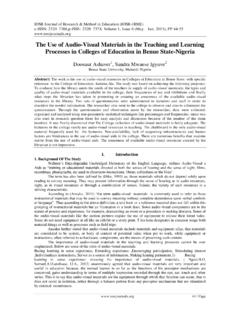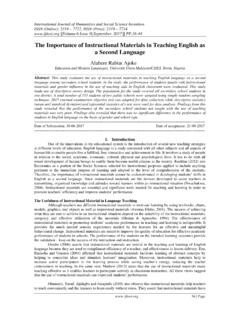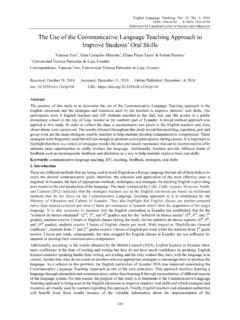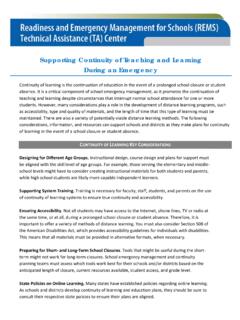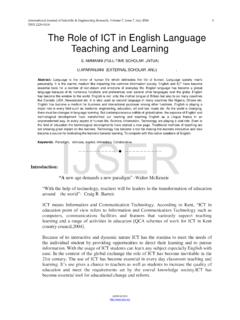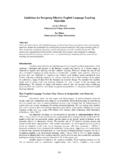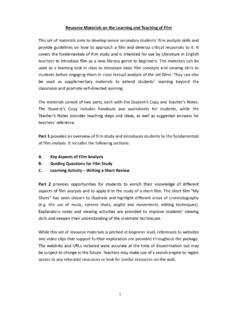Transcription of AVAILABILITY AND USE OF INSTRUCTIONAL MATERIALS IN …
1 International Journal of Education and Practice, 2015, 3(6): 224-234 Corresponding author DOI: ISSN(e): 2310-3868/ISSN(p): 2311-6897 2015 Pak Publishing Group. All Rights Reserved. 224 AVAILABILITY AND USE OF INSTRUCTIONAL MATERIALS IN THE teaching OF CONFLICT AND CONFLICT RESOLUTION IN PRIMARY SCHOOLS IN NANDI NORTH DISTRICT, KENYA Hilda Ng etich Tuimur1 --- Bernard Chemwei2 1 Mosoriot Teachers Training College, Kenya 2 Department of Education Kabarak University, Kenya ABSTRACT This paper examines the AVAILABILITY and use of INSTRUCTIONAL resources necessary for teaching Conflict and Conflict Resolution as a topic in Social Studies subject in primary schools in Nandi North District in Kenya. The study was carried out through descriptive survey. The study population included Social Studies teachers in Kosirai Division of Nandi North District. From this population, a sample of 45 standard seven Social Studies teachers was drawn using purposive sampling.
2 The instruments used for data collection were: a questionnaire, document analysis and classroom observation checklist. Descriptive statistics namely: frequencies and percentages were used to analyze the data. The findings of the study showed that many of the primary school Social Studies teachers had not attended any in-service courses to induct them on how to teach emerging issues like Conflict and Conflict Resolution in the current primary curriculum. The teachers also lacked sufficient INSTRUCTIONAL MATERIALS for effective teaching of the topic. The conclusion drawn from the study was that the current preparation of teachers to teach Conflict and Conflict Resolution is inadequate with regards to their ability to design relevant teaching and learning resources and effectively use them in the teaching and learning process. In addition the available INSTRUCTIONAL MATERIALS in the sampled schools were insufficient.
3 The study recommended the need for Social Studies teachers to be retrained and sensitized on the appropriate INSTRUCTIONAL MATERIALS for teaching Conflict and Conflict Resolution. 2015 Pak Publishing Group. All Rights Reserved. Keywords: AVAILABILITY , Use, INSTRUCTIONAL MATERIALS , teaching , Conflict, Conflict resolution, Primary schools, Nandi North district, Kenya. International Journal of Education and Practice ISSN(e): 2310-3868/ISSN(p): 2311-6897 journal homepage: International Journal of Education and Practice, 2015, 3(6): 224-234 2015 Pak Publishing Group. All Rights Reserved. 225 Contribution/ Originality Learning occurs best when a multiplicity of senses are involved, other than overreliance on verbal communication alone. INSTRUCTIONAL MATERIALS are quite important for effective teaching of conflict and conflict resolution. As such, this study contributes in the existing literature of INSTRUCTIONAL technology because there exist a lot of constraints in the effective teaching of Social Studies and by implication conflict and conflict resolution in Kenyan schools.
4 This study will be useful to teachers who will carefully select and skillfully handle the resources to make their teaching effective. Besides they will be able to know the criteria for selecting and evaluating resources. This study provides information to Ministry of Education on the prevalent practices/approaches regarding the implementation of the topic (being an emerging issue) in the primary Social Studies curriculum. It will also provide information on INSTRUCTIONAL MATERIALS to publishers so that they can prepare relevant teaching /learning MATERIALS . 1. INTRODUCTION One important dimension in teacher education that is getting a lot of attention is related to the use of INSTRUCTIONAL MATERIALS . INSTRUCTIONAL MATERIALS are those MATERIALS used by a teacher to simplify their teaching . They include both visual and audio - visual aids and could either be concrete or non-concrete. These INSTRUCTIONAL MATERIALS bring life to learning by stimulating students to learn.
5 The use of INSTRUCTIONAL MATERIALS in the classroom has the potential to help the teacher explain new concepts clearly, resulting in better student understanding of the concepts being taught. However, they are not ends in themselves but they are means to an end (Kadzera, 2006). It is held that good teaching resources can never replace the teacher but the teacher uses them to achieve their teaching and learning objectives. Some of the INSTRUCTIONAL MATERIALS necessary for effective teaching and learning of Social Studies include the chalkboard, models, graphs, charts, maps, pictures, diagrams, cartoons, slides, filmstrips, radio, and television (Kochhar, 1991). The importance of the use of these MATERIALS cannot be underscored. This has been emphasized by a number of scholars. Lockheed (1991) says that INSTRUCTIONAL MATERIALS are critical ingredients in learning and that the curriculum could not be easily implemented without them.
6 Kochhar (1991) adds that a teacher who has adequate and relevant teaching facilities is more confident, effective and productive. Similar sentiments are shared by Steel (1983) who asserts that relevant INSTRUCTIONAL MATERIALS enable the learners to have a clear understanding of Conflict and Conflict Resolution. INSTRUCTIONAL MATERIALS are essential since they help the teacher and learners avoid overemphasis on recitation and rote learning that can easily dominate a lesson. Resource MATERIALS allow learners to have practical experiences which help them to develop skills and concepts and to work in a variety of ways. The work of Sampath (1990) graphically explain that people learn more through the senses of sight and hearing compared to other senses. International Journal of Education and Practice, 2015, 3(6): 224-234 2015 Pak Publishing Group. All Rights Reserved. 226 Table-1. Percentages of what is learnt using Different Senses Senses used when Learning % of what is learnt Taste Touch Small Hearing Sight Total Source: Sampath (1990) Sampath also notes that we remember more when we see, hear, say and do.
7 Table-2. What is remembered from Learning Activities using Different Senses Learning Activity % of what is remembered What we read 10 What we hear 20 What we see 30 What we see and hear 50 What we say and do 80 Source: Sampath (1990) The implication here is that for more knowledge to be internalized, more of the learner s senses have to be stimulated other than hearing alone. In learning and teaching , the various senses can be stimulated through the use of audiovisual MATERIALS . In teaching Conflict and Conflict Resolution, the Non-Violence Education Programme asserts that the flip chart teaching tool is a stand-alone material that can be used in any classroom without the expense of additional resource. At the same time, Walkin (1982) says that INSTRUCTIONAL MATERIALS have to meet the learning objectives, be validated and their impact be evaluated. But Jarolimek and Parker (1993) are of the view that INSTRUCTIONAL MATERIALS for Social Studies need to be evaluated carefully before, during and after they have been used.
8 This is because it is the teacher and not the media who produce exciting programmes for children. As such, apart from being available and adequate, INSTRUCTIONAL MATERIALS should also be used appropriately. No material is entirely self- teaching ; they all require a teacher to set the stage for learning to take place because MATERIALS of instruction can be no better than the teachers who use them. In summary, Romiszowski (1988); Walkin (1982) and Hills (1982) concur on the fact that if INSTRUCTIONAL MATERIALS are properly selected and used, the following would occur: Learning would be interesting and meaningful. Knowledge acquired would be retained for a longer time. Different skills would be acquired by learners. Students would be actively involved during lessons. From the above views, it is clear that INSTRUCTIONAL MATERIALS are essential for effective teaching of Conflict and Conflict Resolution in Social Studies and should be made adequately available in all schools.
9 To help teachers become better teachers, most schools in developed countries are provided with a variety of INSTRUCTIONAL MATERIALS and equipment. But the situation in Primary International Journal of Education and Practice, 2015, 3(6): 224-234 2015 Pak Publishing Group. All Rights Reserved. 227 schools in Kenya is quite different. The Kenya Institute of Curriculum Development (KICD) carried out a summative evaluation of the 8-4-4 in the secondary school curriculum. It emerged that if learning MATERIALS were to be used effectively, then there was need for provision of adequate resources and facilities. teaching MATERIALS needed for inquiry methods are sometimes non-existent and relatively expensive when available. Ogoma (1987) in a survey on resources for teaching in Nairobi primary schools, has found that teachers are not eager to use the available INSTRUCTIONAL MATERIALS or even produce them.
10 Komen (1991) in a similar study in Baringo District, found out that INSTRUCTIONAL MATERIALS are inadequate. Similarly, Malakwen (2000) on teacher trainers and trainees attitudes towards the implementation of Social Studies curriculum in Kenya s Teacher education institutions, noted that the MATERIALS that trainees use in preparation for teaching practice in primary schools are inadequate and of low quality. Most of these studies on the teaching of Social Studies were carried out before the introduction of the new Social Studies Syllabus in 2002. In the new syllabus, emerging issues like Conflict and Conflict Resolution have been introduced. For these topics to be effectively taught there is need to adequately avail and effectively utilize INSTRUCTIONAL MATERIALS . This paper, therefore, assesses the AVAILABILITY and use of INSTRUCTIONAL MATERIALS by Social Studies teachers in primary schools in Kenya in teaching Conflict and Conflict Resolution.










